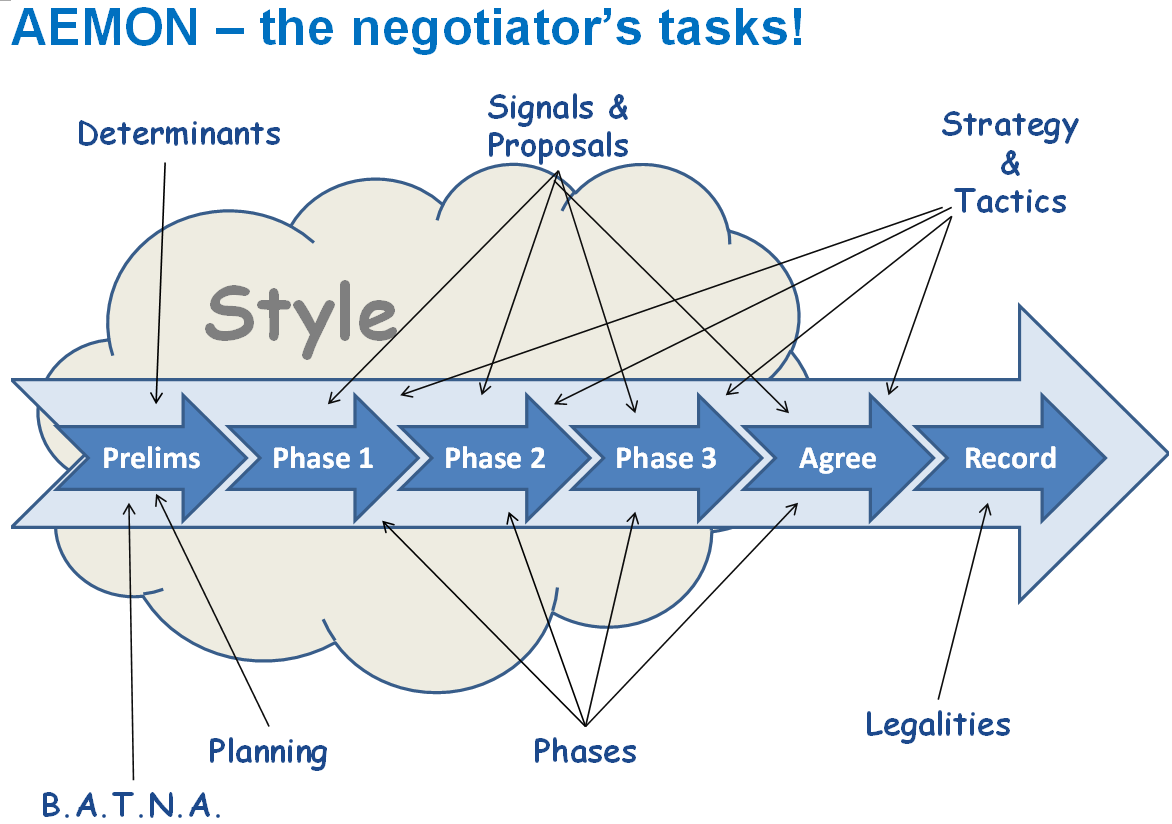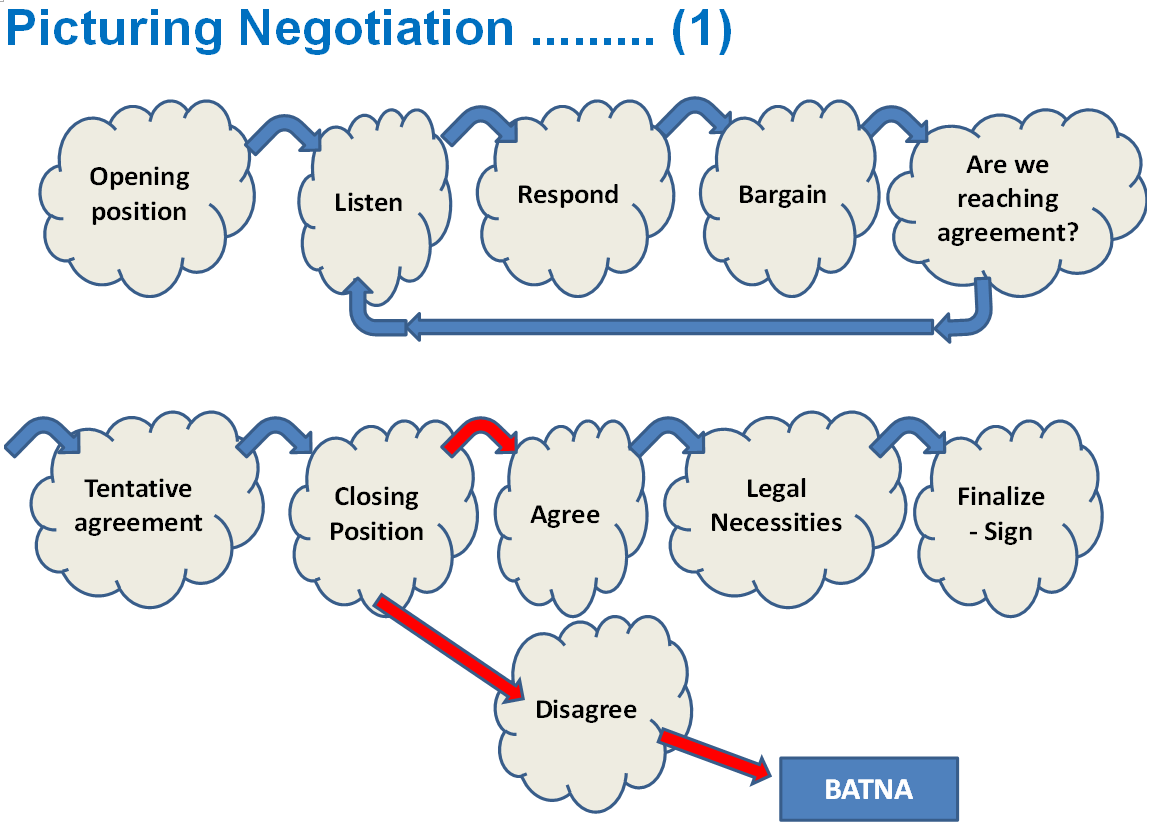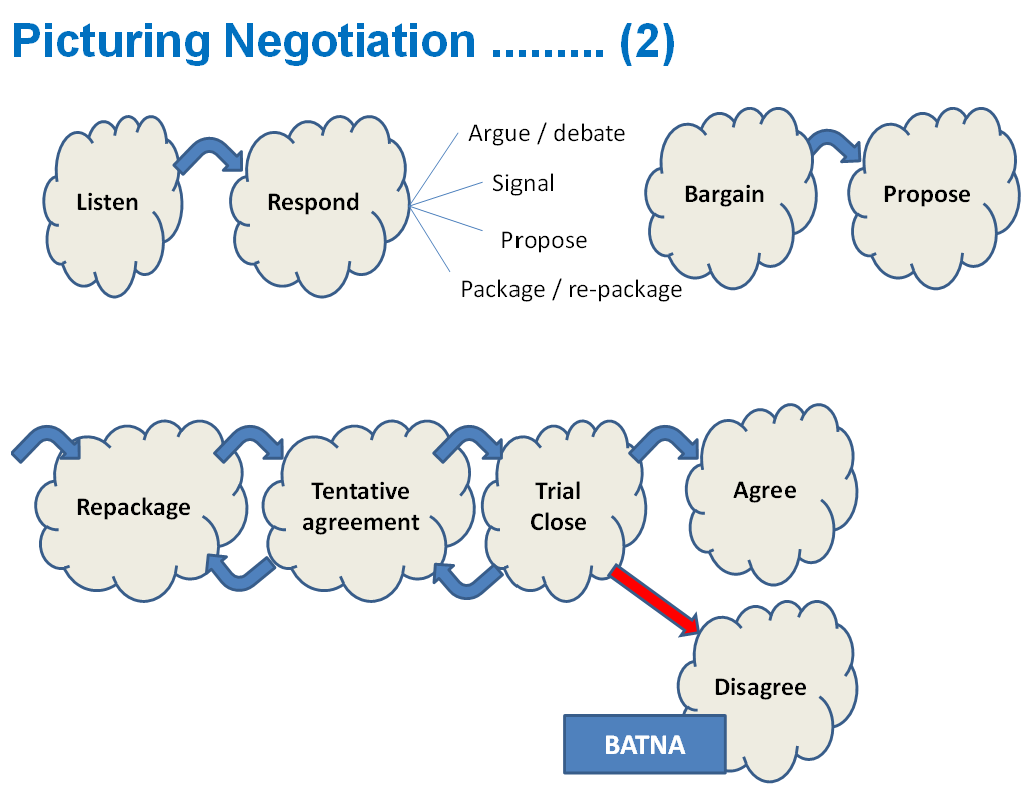Key ingredient – AEMON - what is it?
Negotiation is a core skill for all commercial practitioners and most managers will have taken formal negotiation training at some point. Some of us are natural born negotiators; others must laboriously learn then hone our skills. We all can improve our skill-enhancing efforts to get better negotiation outcomes, but we may be missing a key component to negotiation success that I call the All-Encompassing Model of Negotiation (AEMON) that fits, almost universally, all commercial negotiations. This article drills into why and how AEMON could become the cornerstone of your next negotiation strategy.
Characterize your negotiation
Before you go further with AEMON, ask yourself:
- Do you recognize a distinction between encounter-based and process-based negotiation?
- Do you think in terms of a process? If so, how do you plan to manage that process?
- To what extent do you share a common negotiation mindset with your colleagues? And how important is this to your organization?
Much negotiation training assumes a face-to-face encounter leading to a defined outcome – normally a final agreement – but it can also take you to an ‘agreement to disagree’ or ‘walk away.’ Face-to-face encounter is a reasonably common practice, highly favored in high-level, high-stakes, high-pressure strategic negotiations where the parties need to resolve their questions or differences quickly. You undoubtedly need to be prepared for this type of face-to-face encounter especially the higher you move up the chain of command.
I call this challenge an encounter-based negotiation (EBN). Sometimes a single high-pressure encounter (meeting) will be enough to resolve issues and reach agreement. Other times such negotiations may stretch over several days via a series of meetings that move you progressively closer to final agreement where your encounter-based negotiation will be a single negotiation but carried-out among several – or many – face-to-face encounters.
Either way, our skill sets, tactics, and behaviors will generally be broadly recognized, understood, and applied. But what can happen when we try to match classic negotiation training with real-world experiences? Within that practical challenge, these EBNs can become a game involving certain rules and conventions we might apply or need to ignore. Indeed, we may be rewarded for doing this – or penalized – depending on how dedicated some people are to using this gaming approach, an adjacent part of which is game theory.[1] This involves the trend of increasingly embedding relationship governance and strategic choice-making into strategic thinking and practice. As a contracts professional I welcome this trend. It should lead to more rational decisions and even to better contracts.
As we consider encounter type negotiations, we face two key questions:
- Is the EBN style of negotiation is the only way or even the best way to negotiate?
- Are negotiations optimally more nuanced (reflecting complex qualities) and hybrid (or varied) in structure?
Real-world events rarely reflect the typical negotiation training course taught in the classroom. In the real world, we perform formal and informal negotiations by phone, face-to-face, virtual correspondence and sometimes we negotiate across long time periods. We can call these process-based negotiations (PBNs). Understanding PBN-type negotiation demands a better approach to learning precisely where we are in any extended negotiation process and what we want to happen next.
So far, so logical on paper, but few training courses major in PBN. In most courses, if the reality of PBN is highlighted at all, it is merely in the standardized idea of post-EBN follow up and review after the encounter. But that informal process misses the point. We need more detail about proven processes that work.
Before we examine further detail about how to recognize and manage PBN, we need to examine the AEMON process maps (Figures 1 – 4).
Figure 1. AEMON negotiation phases
Simply put, this process with preliminaries is followed by a three-phase encounter followed by agreement – or occasionally by a disagreement and walk away. When we negotiate, we need to present our case, understand the position of the other party, and agree on outcomes we want. Most negotiation experts recognize these three phases including an agreement stage as follows:
- build
- narrow
- close
Let’s put some flesh on this:
- Build means we are presenting our case and building its validity in the other party’s mind. Likewise, the counterparty is presenting and building their case. A lot of this is about opening positions.
- Narrow means both parties move progressively towards a clear understanding, reducing differences and establishing what overall solution may work and be mutually acceptable.
- Close is that phase where we reach a position that can become a successful basis for a deal between the parties.
Agree is when the parties take the plunge and settle on a solution. Few training courses focus much on preliminary actions except to suggest that we need to do some practical pre-negotiation planning. These courses pay very little attention to adequately recording the results of the negotiation and then translating the results into legal certainties that shape the contract. Yet any commercial negotiation between organizations is likely to lead to some type of written agreement and usually to a formal contract relationship.
We can transpose certain ideas into this process map (Figure 1). One key consideration is that our personal approach, background, personality, and prejudices will both influence the process and the way we behave. Some call this personal style that essentially influences outcome because it sits behind everything that happens. See Figure 2.

Figure 2. Style influences outcome
Understanding and recognizing ‘style’ as a practical question will enable us to better guide our own behaviors as well as anticipate the counterparty’s overall approach. Whether we are negotiating via EBN or PBN, we will recognize certain determinants (that are likely to impact negotiated outcomes) and as part of this we will develop a BATNA, or Best Alternative to Negotiated Agreement, defined as representing the best option to our party in a negotiation, in the event we fail to reach agreement.2
BATNA is commonly used as a basis for recognizing when we are failing to reach an acceptable outcome and giving us confidence we know what we will do if we have to ‘walk away’. It also helps us in making proposals and counterproposals and applying strategy and tactics. But at the end of the day, we are going to be faced with legalities to settle in a formalized way. Occasionally these later efforts to express legalities can undermine, upset, or even reopen the earlier negotiation phase – so we want to handle this at the outset as skillfully and professionally as we can!
So, be prepared – as part of this standardized AEMON approach, you will encounter the following phases or aspects in the following (approximate) order:
- problem,
- people,
- prioritize,
- prepare,
- plan,
- pre-position,
- practicalities,
- pleasantries,
- positions,
- parley/persuade,
- package and move on to final agreement which will be further characterized by its
- particulars,
- period,
- pragmatism and
- privity.
And just to complete this insight I would add that we must:
- pilot through the process as commercial managers, and then once the agreement is underway, we must:
- perform, police, pre-empt (if things go wrong) and
- be always proactive!
Another way to describe all negotiations – and we might say this is another aspect of AEMON – is that we can picture the process once it is formally underway – whether it is a EBN or a PBN – as defined above. See Figure 3.

Figure 3. Negotiation flow from opening position to agreement or best alternative to negotiated agreement (BATNA)
Beginning and end
Hopefully at this point we are all reasonably comfortable with the idea of an AEMON once we understand that our all-encompassing, universal model will probably work as well in China as in the USA, Latin America, or Africa.
As negotiators we need to present our case, understand the other side’s case, and reach agreement on outcomes (via the phases stated above, specifically build, narrow, and close). But as part of this process, we also need to:
- understand that there is a process and
- know precisely where we are in that process at any given point.
Beware of unexpected end-results! I suggest that training courses and the wider literature can underplay -- and sometimes totally ignore -- the preliminaries that can happen well before actual negotiations and overlook the need to pilot the process right through to a formal agreement. Such oversights can unravel the contract!
We all know that, even with the best intentions in the world, genuinely agreed arrangements can get seriously unstuck in the contract drafting task especially if the task of preparing contract documentation is handed over to individuals who might not entirely understand the deal that has been agreed and possibly think it is their role to secure further non-negotiated advantages for their side.
We have all seen this. For example, I once co-presented a course in Vienna about fast contracting for a client which -- regardless of its widespread business operations -- found it could rarely get contracts signed within any reasonable timeframe. This led to some genuinely interesting conversations and a certain amount of organizational soul-searching. The client did finally improve, but it required a really determined effort, with senior management buy-in and ongoing support. The experience spawned an important lesson learned.
So, I repeat that, as organizations and as individuals, we can be overly focused on the exciting, even ‘sexy’, EBN – and that is where the bulk of training tends to focus, but this fails to recognize that the mundane reality may well be that we are living in a PBN paradigm most of the time. Do we fail to face or do we adequately handle those early and later phases, and ensure these are mapped into our process and onto our project timelines?
I would love to provide links to scholarly articles on PBN but the literature on this is genuinely thin. Some behavior specialists, who have tended to be the leading lights in negotiation theory, largely ignore the early preliminaries and the later determination required to tie down a legally-sound agreement.
Furthermore, EBNs are generally easier to understand and characterize than PBNs. PBNs may be seen, by contrast, as being rather mundane, and wearying both to track and manage! As a result,
we tend to have insufficient insight on managing the ongoing relationship by repeatedly asking the practical questions like what can must I perform, how can I police and pre-empt, and how can I be proactive at all times? This lack of insight suggests that the poor old contract manager may wind-up having to live with the consequences of a PBN that was earlier handled as though it had been an EBN.
Long live AEMON!
AEMON is genuinely an all-encompassing model, but within it, you may also find a wide range of mechanisms and practices working. A negotiation can be short and sweet (well, rarely sweet!) or long and drawn-out. But we need to recognize the model as a model, and to apply adequate attention, resource, and time fame to the beginning and to the end of the process. In concluding this short article, I offer one more schematic but I will not comment in detail. It is likely that many readers will understand this intuitively, in any case:

Figure 4. The road to agreement or BATNA (might get bumpy)!
A more granular representation of the idea that in any negotiation --whether it is an EBN or a PBN -- within the overall communication process between the counterparties, you will likely face the tasks of listening/decoding, responding, bargaining, packaging and even re-packaging -- all leading to a trial close and the suggestion that negotiation is, in fact, often far more about process than encounter.
Ask:
- Do we take this into account adequately?
- And even if we do, as commercial experts, do our colleagues?
I think the answer is too often ‘no’ and consequently we may well see value-leakage from our commercial arrangements because we fail to handle the negotiation(s) as a process and fail to adequately plan for the necessary legalities during the phase I call “Record” in the AEMON above. (Figure 2).
I once attended a five-day negotiation course which was compulsory for all senior commercial managers. So, it covered not “just” procurement and sales, but also senior engineers, other senior corporate personnel, and the various commercial teams. It gave us, organizationally, a common language and common mindset and helped us perform better as a team. But even this course failed to acknowledge that there is in truth an AEMON you can apply almost universally to commercial negotiations.
Time to up our game?
END NOTES
- Game theory as described by Investopedia and Wikipedia
- A strong BATNA means that that party has a reasonably attractive alternative to negotiation; if they fail to reach agreement, they can implement the BATNA with minimal disruption. Ref Investopedia article titled Best Alternative to a Negotiated Agreement, James Chen, Thomas Brock, See also Corporate Financial Institute’s (CFI’s) article titled What is BATNA?
ABOUT THE AUTHOR
Peter Sammons is a business trainer with Procurement Central in the UK. Author of several books available online, Peter published Contact Management, Core Business Competence in 2017. The preview of this work may be found here. As well, his recent book Right First Time – Buying and Integrating Advanced Technology looks in depth at a challenging subject area. It is available as hard or soft copy: IT Governance Publishing Ltd, UK – Peter Sammons
CONTACT INFORMATION